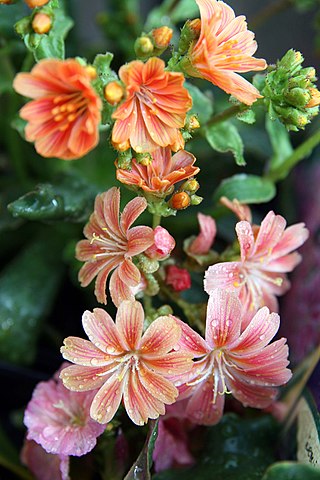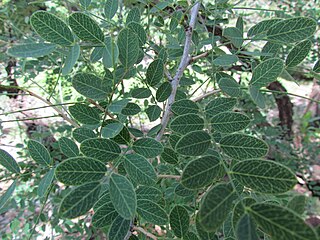
Cercocarpus, commonly known as mountain mahogany, is a small genus of at least nine species of nitrogen-fixing flowering plants in the rose family, Rosaceae. They are native to the western United States and northern Mexico, where they grow in chaparral and semidesert habitats and climates, often at high altitudes. Several are found in the California chaparral and woodlands ecoregion.

Toxicoscordion venenosum, with the common names death camas and meadow death camas, is a species of flowering plant in the family Melanthiaceae. It is named for its well known toxic qualities, with both its common names and its scientific name referencing this. Because its nectar is also poisonous, it is mainly pollinated by the death camas miner bee, which specializes in collecting the toxic pollen for its young. It is native to western North America from New Mexico to Saskatchewan and west to the Pacific Ocean.

Claytonia is a genus of flowering plants native to Asia, North America, and Central America. The vitamin-rich leaves can be eaten raw or cooked, and the tubers can be prepared like potatoes.

Polyscias racemosa, or false 'ohe, is a species of flowering plant in the family Araliaceae. As Munroidendron racemosum, the species was until recently considered to be the only species in the monotypic genus Munroidendron. With the change in classification, Munroidendron is now obsolete. Polyscias racemosa is endemic to the Hawaiian island of Kauai. It is very rare in the wild and some of its original habitat has been replaced by sugar cane plantations. It was thought for some time to be probably extinct, but was rediscovered a few years prior to 1967.

Lewisia is a plant genus, named for the American explorer Meriwether Lewis (1774-1809) who encountered the species in 1806. The native habitat of Lewisia species is rocky ground and cliffs in western North America. Native Americans ate the roots, which have also been used to treat sore throats.

Psorothamnus is a genus of plants in the legume family. These are shrubs and small trees. Many are known by the general common name indigo bush. Some are referred to as daleas, as this genus was once included in genus Dalea. These are generally thorny, thickly branched, strongly scented bushes. Most species bear lupinlike raceme inflorescences of bright purple legume flowers and gland-rich pods. Psorothamnus species are native to the southwestern United States and northern Mexico. The genus is paraphyletic and it has been proposed that the genus Psorodendron be reinstated to accommodate sections Xylodalea, Capnodendron, and Winnemucca.

Heliocarpus is a genus of flowering plants in the family Malvaceae. It was formerly classified in the Tiliaceae.

Sambucus racemosa is a species of elderberry known by the common names red elderberry and red-berried elder.

Diphysa is a genus of flowering plants in the legume family, Fabaceae. It belongs to the subfamily Faboideae, and was recently assigned to the informal monophyletic Dalbergia clade of the Dalbergieae. It includes 22 species which range from Arizona through Mexico and Central America to Colombia and Venezuela.

Orbexilum, commonly called leather-root, is a genus of flowering plants in the legume family (Fabaceae). They are native to North America, where they are found in the United States and Mexico, south to Chiapas.

Peteria is a genus of flowering plants in the legume family, Fabaceae. It belongs to the subfamily Faboideae. It is native to USA and Mexico.

Lopezia is a genus of plants of the family Onagraceae, largely restricted to Mexico and Central America.

Thelypodiopsis is a genus of flowering plants belonging to the family Brassicaceae.
Chlorocrambe is a genus of flowering plants belonging to the family Brassicaceae.
Suckleya is a monotypic genus of flowering plants belonging to the family Amaranthaceae. It only contains one known species, Suckleya suckleyana(Torr.) Rydb.
Howelliella is a monotypic genus of flowering plants belonging to the family Plantaginaceae. It only contains one species, Howelliella ovata.

Giliastrum is a genus of flowering plants belonging to the family Polemoniaceae.

Guilfoylia is a monotypic genus of flowering plants belonging to the family Surianaceae. The only species is Guilfoylia monostylis.

Kelseya is a monotypic genus of flowering plants belonging to the family Rosaceae. The only species is Kelseya uniflora. It is commonly called the oneflower kelseya, spiraea or alpine laurel. The genus was named in honor of Francis Duncan Kelsey, a Montana resident botanist, who discovered the plant in 1888 at the "Gate of the Mountains" near Townsend.
















